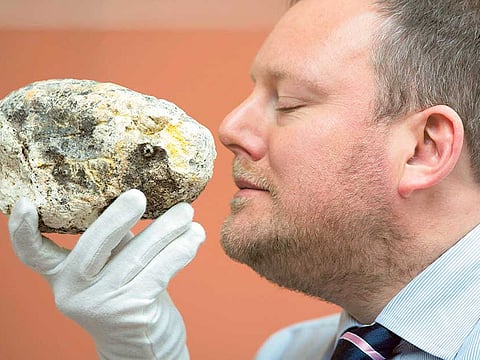Smelling a fortune: Dh263,443 from whale’s vomit
A lump of whale ‘vomit’ is just one of many smelly ingredients in scent

London: A Lancashire couple hit an unlikely jackpot last week when — lured by the stench of rotting fish — they stumbled across a lump of whale detritus on a beach. Ambergris, a product of the digestive system of sperm whales, has long been deployed by perfumers to add a certain something to their wares, despite its unpropitious air.
Eagle-eyed and clearly robustly nosed engineer Gary Williams described his find as smelling “like a cross between squid and farmyard manure.” Nevertheless, this unprepossessing 14.5kg Morecambe Bay nugget is expected to sell for £50,000 (Dh263,443), a windfall with which Williams hopes to buy a caravan.
He and wife Angela are in negotiations with prospective buyers in France and New Zealand. Another 2.72kg lump was found in the area three years ago, valued at £120,000.
Despite conservation fears, ambergris remains on ingredient lists — in Dior’s Poison, Molinard’s Habitana and Creed’s Green Irish Tweed, for example — presumably in its synthetic form of ambroxan. Those of us who have inhaled it will not forget the experience.
Fragrance entrepreneur Roja Dove once unveiled a block for me at Claridge’s — an act that we were rather more enthusiastic about than our fellow customers. Traditionally considered to be vomitous in origin, now thought to be faecal, and largely comprised of undigested squid beaks, ambergris may bob about in the ocean for 30 years before being washed up.
Seedy underbelly
As it floats, a white film forms on its greyish exterior as it oxidises in salt water. The lighter the hue, the longer the piece will have been at sea and the lighter and sweeter its scent; lighter and sweeter being relative terms for an object that can only be described as dank, fishy and disturbing — if rather unearthily fantastic.
And, yet, what poetry it becomes in the alchemy of perfume. James Craven, historian and archivist for perfumery Les Senteurs, enthuses: “Ambergris lends a scent a tenacious depth, richness, opulence, smoothness, ambiguity and an unsettling ‘do I love it, or hate it?’ quality.It prompts the intriguing thought: ‘I am divinely scented and delicious, but am I entirely clean?’
“Its use can seem rather mythical on investigation, not least now the world is so whale wary. Creed certainly uses it in many of the house’s 20th-century scents. It was in Miss Dior and Rochas’s original Femme.”
Craven continues: “And I can vouch for its appearance in the Coronation Oil, the chrism made for Charles I and more or less replicated for Elizabeth II. I have smelled it: neroli, spices, rose and real ambergris.”
Still, whale excrement isn’t the half of it. People may like to think of perfume as being all hearts and flowers.
However, it is its seedy, animal underbelly that makes us crave it. Countless classics contain more than a glimpse of “something nasty in the woodshed”: primitive, distinctly feral base notes that belie the bouquets in their upper spheres.
Many of perfumery’s most venerable creations owe their sensuality to the use of animal ingredients with a certain “spray” element.
There is civet, a faecal paste extracted from the anal glands of the civet cat, traditionally harvested by poking caged cats. Today’s animal magic mostly comes in synthetic guise. However, the gutsiness of fragrances such as Chanel No 5 and Guerlain’s Shalimar is owed to this tradition.
Musk secreted from the sheath gland of the musk deer is at its most redolent in Dana’s Tabu. Castoreum, a leathery emission from the genital scent sacs of the castor beaver (and my own personal favourite) is ripely evident in Balmain’s Jolie Madame.
Craven points to the use of the oil hyraceum — “basically made from the fossilised urine and faeces of a sort of dirty prairie dog” in Papillon Perfumes’ Salome, sold at Les Senteurs.
“It smells as you would expect — really most intriguing.”
Certainly, it makes the current excitement over Boots’ decision to include gooseberry in its latest No 7 wonder serum seem excessive. Perfumers have never been backward about coming forward in using such ingredients to conjure life’s wilder side. Early 20th-century genius Jacques Guerlain — creator of Jicky, Shalimar and Mitsouko — noted that his perfumes should recall his mistress’s scent, while designer Tom Ford declared that he wanted his Black Orchid to smell like a man.
The mid-20th-century perfumer Germaine Cellier was inspired to create Piguet’s Bandit by smelling undergarments of models as they returned from the catwalk.
Generations of scent sensualists have endeavoured to add outre elements to their concoctions, be it sweat, soiled skin, clammy saddles, curry, petrol, liquor, rotting roses, oral abscesses, dirt, tobacco, industrial buildings, lunar landscapes, and — in the case of enfants terribles perfumers Christoph Hornetz and Christophe Laudamiel — the scent of a navel.
Should all this come as an unpleasant surprise, James Craven provides comfort and explanation: “We humans explore ourselves through scent, and find our shadow side — that often resented, even sinister, darker self. And so perfume is by no means all sweetness and light, moonbeams and gardenias.”
“Scent can be therapeutic, like a rigorous session with the psychoanalyst, helping us to realise our potential, and come to terms with our inner, often unspeakable urges.
“We can ‘work through’ our neuroses via the perfume cabinet and may even start to enjoy these aspects. Fragrance — like ghostly marsh lights — can lead us into, and through, the mire.”
— The Telegraph Group Limited, London 2016
Sign up for the Daily Briefing
Get the latest news and updates straight to your inbox



